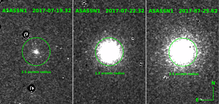ASASSN1
 ASAS-SN discovery image and 2 more epochs of Comet ASASSN1. | |
| Discovery | |
|---|---|
| Discovered by | All Sky Automated Survey for SuperNovae |
| Discovery date | July 19th 2017 |
| Alternative designations | C/2017 O1 |
Comet ASASSN1 (IAU designation C/2017 O1) is a bright comet discovered by the All Sky Automated Survey for SuperNovae (ASAS-SN). It was first detected on July 19, 2017, located in the southern constellation Cetus.
Discovery
During the ongoing ASAS-SN survey, using data from the quadruple 14-cm "Cassius" telescope on Cerro Tololo, Chile, a possible new moving transient source was detected on July 19, 2017; the team gave it the designation ASASSN1. [1]
In the discovery images, ASASSN1 had a V band magnitude of 15.3. The centroid was moving between the ASAS-SN three 90 second, dithered discovery images with no counterpart in the Minor Planet Center database. Follow-up images from the Savannah Skies Observatory recovered ASASSN1 9.7 hours later 0.21 degrees away. These observations revealed Comet ASASSN1 had a halo at least 25 arcsec in radius, a compact core, and no clear tail. Further observations were made using the Las Cumbres Observatory 1m at CTIO 24.7 hours after discovery which recovered ASASSN1 at a g-band magnitude of 15.2. ASASSN1 was then found 0.77 degrees away from ASASSN1's original location 35.7 hours after discovery. ASAS-SN's Cassius unit re-observed this field 3 days after discovery and found that ASASSN1 significantly brightened to V band 11.9 magnitude. In addition to brightening, the coma around ASASSN1 also increased significantly to 2.5 arcmin. Finally, the northern ASAS-SN unit, a quadruple 14-cm "Brutus" telescope on Haleakala Hawaii, observed ASASSN1 6 days after discovery and found that ASASSN1 appears to have faded to V~12.2.
References
- ↑ Prieto, Jose (July 25, 2017). "ASASSN1: Bright Comet Discovered by the All Sky Automated Survey for SuperNovae". Retrieved July 25, 2017.

